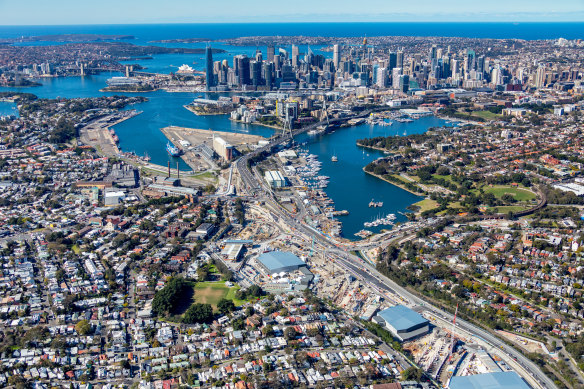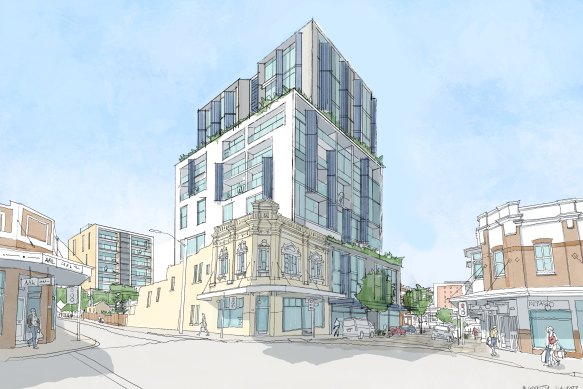New Zealand has given us Crowded House, Russell Crowe and pavlova – could it now deliver us an elegant solution to the housing affordability crisis?
The Kiwi government has laid down the gauntlet to the country’s five biggest cities with two major pieces of urban planning law designed to boost density.

As Sydney grapples with its persistent housing affordability crisis, could New Zealand show us the way on density?Credit: Sydneyimages
First came the National Policy Statement on Urban Development, which required councils such as Auckland to automatically permit apartment buildings of six storeys within walking distance of the city centre, metropolitan centres, train stations and rapid bus corridors.
Late last year, the government passed a housing bill that applied new Medium Density Residential Standards, which allow landowners to build three dwellings of up to three stories on most blocks in those five fast-growing cities (also including Hamilton, Tauranga, Wellington, and Christchurch)
They’re not moving slowly, either. Councils were required to notify the changes by August and in Auckland public submissions will close at the end of this month.
The city of 1.7 million people had already been on a density drive since 2016, when it up-zoned nearly all of its inner suburban area. A recent report found Auckland built an additional 27,000 homes as a result of the relaxed planning laws; in other words, it was a raging success in increasing supply.
Bill McKay, a senior lecturer in architecture and planning at the University of Auckland, says the newest reforms – which were a bipartisan effort from the Labour government and National party – are an important, if radical, step forward.
“It’s a really blunt instrument, but it’s necessary,” he says. “I liken these planning things to filling the bath. When you go to fill the bath, you turn the taps on full. Then you come back and you check it and adjust it. I think we need to turn the taps on radically if we’re really to deal with [creating] an equitable society.”
McKay says the second change – the one that allows suburban property owners to build townhouses in place of their old villas and bungalows – has prompted the most animosity from so-called “not in my backyard” types. “They’re all going, ‘F--- me, I could suddenly end up with three three-storey townhouses next door’,” he says.
McKay says the backlash is coming chiefly from well-off residents in leafy suburbs, as well as heritage conservationists who argue the changes will destroy the character of neighbourhoods.
“They all tend to be older people,” he says. “But younger people are supporting it because it’s going to provide them with the faint possibility of being able to afford a roof over their heads. It’s a bit of a culture war between young and old.”
Sound familiar? In Sydney, where the median house price is $1.5 million and the median apartment rent has risen to $525 a week, these tensions over planning and development are sharper than ever.
On Wednesday, the Grattan Institute’s housing economic policy director Brendan Coates warned NIMBY objections had driven up house prices and rents in Australia’s big cities, and said state and federal governments needed to make tough decisions.
“Either people accept greater density in their suburb or their children will not be able to buy a home, and seniors will not be able to downsize in the suburb where they live,” he said in his Henry George Commemorative Lecture. “This is a problem we can fix, but only if we make the right choices.”
Coates tells the Herald we ought to look across the ditch for inspiration. In effectively bypassing council planning powers, the New Zealand reforms overcome one of the major impediments to building more homes, he says.
“If that kind of up-zoning had occurred in Australia, it would be equivalent to house prices and rents falling by about 10 per cent,” he says of Auckland’s 2016 changes. “In New Zealand it was offset by the fact that interest rates fell.”
Under NZ’s recent national reforms, most developments that comply with the controls do not need to obtain planning (or “resource”) consent. They still need to obtain building consent, which deals with the actual plans, measurements and engineering. And Auckland Council warns that owners wishing to subdivide their property or assess the earthworks needed for construction may still require resource consent.
And it’s not a free-for-all. A council briefing document on the Auckland Unitary Plan stipulates it can declare certain precincts have “qualifying matters” which reduce the need for or desirability of development intensification.
”While we want to ensure that the AUP provides flexibility and opportunity for developers in precincts, we also need to maintain and enhance the things that residents, workers and visitors within precincts value,” it says.
“If we keep the good things, while enabling growth, we can ensure our precinct areas not only provide high-quality residential intensification but also retain and enhance the local-based characteristics and uniqueness of the area.“
The NSW government has long tried to intensify development around Sydney’s transport corridors. Professor Nicole Gurran, an urban planning expert at the University of Sydney, says much of what Auckland and New Zealand are doing now has happened in Sydney since the 1990s.
Over time, the government has tried to strip councils of their power over development consent by creating local and regional planning panels independent of council, rezoning land near train lines and sometimes taking direct control of developments and precincts.
At a Committee for Sydney summit in February, Cities Minister Rob Stokes said the forthcoming metro rail lines would “shift everything”, agreeing that as much as half of the city’s population growth could be concentrated near those stations.
The Inner West Council is currently grappling with plans to increase density in Marrickville and Dulwich Hill, both of which will be on the City and Southwest metro line, and North Ashfield.
As the Herald reported this week, activist residents are fighting the proposal for apartment blocks of six to eight storeys, possibly 12 in some areas, claiming it will turn a suburban oasis into a “high-rise nightmare”.
Dulwich Hill resident Robert Veal told a packed council meeting on Tuesday night that he detested “middle-class Anglo NIMBYism”, but objected to the “off-the-shelf plan”, which would involve the compulsory acquisition of his home.
“The kind of PR-driven Kumbaya singalongs that have characterised the consultation process to date do not resolve anything, they simply lower our trust and stiffen our opposition,” Veal said.
But Coates, the Grattan Institute expert, says the lengthy consultation processes that typically accompany local environment plans and individual development applications unfairly empower existing residents and older people with more time on their hands.
“The key point is we need to shift the balance away from giving so much attention to the voices of those who live there already ... and give more voice to those who benefit from the housing being built,” he says.

An artist’s impression of how Charlotte Street in North Ashfield could look after high-rise development.
Coates also suggests some community opposition to density would dissipate if design rules were strengthened to create better developments. “The quality of what gets built is often not great.”
Gurran, the Sydney University academic, says the market still has to deliver the homes enabled by rezoning, and that doesn’t always happen. She says zoning near most Sydney train stations likely allows for high density but “if you walk around at eye level and try to guess what the zoning is ... you’d have no chance”.
“One of the risks is you go too far and over-zone willy-nilly because then you get very piecemeal development and a lot of uncertainty for residents,” Gurran says. “You don’t really want to have a low-density house being overlooked by high-density apartments for 20 years.”
Gurran says another long-term concern is once you build three-storey townhouses or six-storey apartment blocks, you won’t be able to increase density any further – which may be a problem.
“I would not be wanting to see a six-storey blanket rule across Sydney unless we’re sure that six storeys is as high as we want to go for the next 70 or 100 years,” she says.
The Morning Edition newsletter is our guide to the day’s most important and interesting stories, analysis and insights. Sign up here.